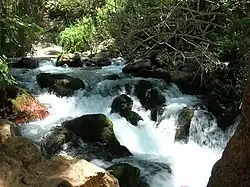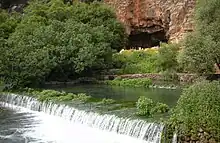Banias River
Banias River (Arabic: نهر بانياس, romanized: Nahr Baniyas; Hebrew: נחל חרמון, romanized: Nahal Hermon)[3] is a river in the Golan Heights. It is the easternmost of the three main northern tributaries of the Jordan River; together with the Dan River and the Hasbani River, it forms the Jordan River's upper catchment (UCJR).[4] Israel has included the stream in the Hermon nature reserve.
| Banias River | |
|---|---|
 | |
| Physical characteristics | |
| Source | |
| • location | Banias spring[1] |
| Mouth | |
• location | Dan River |
• coordinates | 33°11′45″N 35°37′32″E |
| Length | 9 km |
| Basin features | |
| River system | Upper Catchment of the Jordan River |
| Tributaries | |
| • left | Sa'ar Stream Pera' Stream |
| • right | Guvta Stream Sion Stream[2] |
Course and streamflow

The main source of the Banias River is the Banias spring, located at the southern base of the Hermon mountain range and contributing a discharge of 67·million m3 annually. From there the stream flows south for nine kilometers before draining into the Dan River.[1][5] Along the way, it drains the Guvta Stream (right), the Sa'ar Stream (left), the Pera' Stream (left), and the Sion (Ar.: el-'Asl[6]) Stream (right), with a total drainage area of 158 km2. The total annual streamflow of the river comes to 106 million m3.[4]
Flora and fauna
The banks of the river abound in willow trees, oriental planes, silver-leaf poplars, Tabor oaks, Palestine oaks, Mt. Atlas mastics, terebinths, carobs, ferns, giant canes, and various vines.
The stream is home to a variety of fluvial fish, including longhead barbel, large-scale barbel, Damascus barbel, and tilapia. Living and roaming around the stream or in it are wild boars, Syrian rock hyrax, swamp cats, nutria, and Indian porcupines.[7]
Birds that frequent the vicinity of the stream include rock doves and Western rock nuthatch.[8]
References
- Hartmann, Andreas (September 2008). "Process-based modelling of karst springs in Mt. Hermon, Israel" (PDF) (in English and German). University of Freiburg. p. 11. Retrieved 5 August 2011.
Banias Spring is the spring contributing most of the discharge to the Hermon stream.
- "וואלה!מפות" [Walla! Maps]. Walla! (in Hebrew). Retrieved 5 August 2011.
- Central Intelligence Agency (CIA). "Golan Heights and vicinity: October 1994". Library of Congress. Library of Congress Geography and Map Division Washington, D.C. Retrieved 12 December 2019.
- Rimmer, Alon; Salingar, Yigal (2006). Krzysztofowicz, R. (ed.). "Modelling precipitation-streamflow processes in karst basin: The case of the Jordan River sources, Israel" (PDF). Journal of Hydrology. Elsevier. 331 (3–4): 527–528. Bibcode:2006JHyd..331..524R. doi:10.1016/j.jhydrol.2006.06.003. Retrieved 20 July 2011.
Rainfall and snowmelt of Mt. Hermon recharge the main tributaries of the UCJR: (1) Dan (252 x 106 m3 annually); (2) Snir also known as Hatzbani (118 x 106 m3); and (3) Hermon also known as Banias (106 x 106 m3) (Table 2 and Fig. 2).
- "Hermon Stream (Banias) Nature Reserve". Israel Nature and Parks Authority. Archived from the original on 21 July 2011. Retrieved 5 August 2011.
Nine kilometers from its source, the Hermon Stream meets the Dan, and together they form the Jordan River.
- Mark Zeitoun; Karim Eid-Sabbagh; Muna Dajani; Michael Talhami (2012). "Hydro-political Baseline of the Upper Jordan River". Beirut: Association of the Friends of Ibrahim Abd el Al (AFIAL) with the UEA Water Security Research Centre. Retrieved 18 April 2020.
- Hareuveni, Imanuel (1985). "עמק החולה". In Ehud Avishai (ed.). Nature Reserves in Israel (in Hebrew) (2nd ed.). Israel: Ministry of Defense (Israel). pp. 64–66. ISBN 965-05-0193-2.
במי הנחל רבים הדגים, ביניהם: בינית-ארֻכת-רֹאש, בינית גדולת-הקשקשים, חפף, בינון, לבנונית ואמנוּן.
- Baraq, Pinhas. "The Nahal Hermon Reserve (Banias)". Jewish Agency for Israel. Archived from the original on 9 January 2012. Retrieved 7 August 2011.
Sometimes, rock hyrax can be found, lying on the piled-up rocks, and flocks of rock doves nest in depths of caves. You can occasionally spot Neumayer's Rock Nuthatch, which flies from Mount Hermon, and black sweet-water snails (melanopsis praemorsa) lie on the floor of pools.